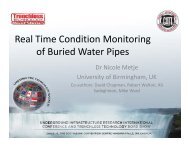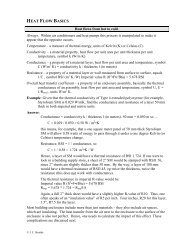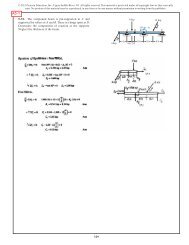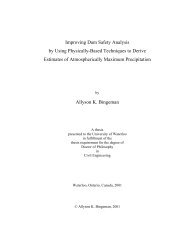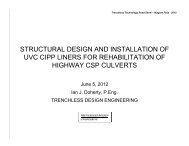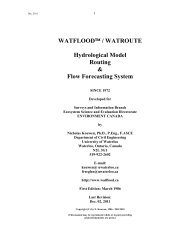Planning Horizontal Directional Drilling for Pipeline Construction
Planning Horizontal Directional Drilling for Pipeline Construction
Planning Horizontal Directional Drilling for Pipeline Construction
You also want an ePaper? Increase the reach of your titles
YUMPU automatically turns print PDFs into web optimized ePapers that Google loves.
6 GEOTECHNICAL CONSIDERATIONS<br />
The design drill path must be developed taking into account the geological setting<br />
<strong>for</strong> the project and geotechnical and hydrogeological issues at the crossing site.<br />
6.1 Geotechnical and Hydrogeological Issues<br />
From a geotechnical perspective, a number of issues should be taken into account<br />
during the HDD feasibility investigation as well as during design and construction<br />
of the directional drill, including:<br />
• the distribution and characteristics of the surficial overburden deposits;<br />
• the presence of high plastic clay and bentonitic shale bedrock materials; and<br />
• the occurrence of structurally complex, hard and/or abrasive bedrock<br />
<strong>for</strong>mations.<br />
These issues are briefly addressed below.<br />
6.1.1 Surficial Overburden Deposits<br />
In general, cohesive soils, such as clays, silty clays and silty-clayey tills, are selfsupporting<br />
and an open bore should be achievable. An open bore can often also be<br />
maintained through “dirty” sands and clayey silts, and even cohesionless clean silt<br />
and sand materials (provided the bore is full of drilling mud). However, medium<br />
to coarse-textured granular materials (e.g., gravels, cobbles and boulders) can give<br />
rise to a number of problems during HDD construction, including:<br />
• bore instability or collapse during drilling of the pilot hole and subsequent<br />
reaming passes, that may result in the drill string becoming stuck;<br />
• loss of drilling fluids to the <strong>for</strong>mation; and<br />
• release of drilling fluids to the environment.<br />
Mitigative measures may include:<br />
• maintaining drilling mud in the bore hole at all times by locating the entry and<br />
exit points above cohesionless silt-sand zones;<br />
• evaluating alternative drill paths that avoid or minimize exposure to the<br />
problematic soil materials;<br />
• casing or excavating through near surface silt, sand or coarse-textured<br />
deposits; and<br />
• using drilling additives to consolidate and reduce the permeability of these<br />
materials.<br />
Strict monitoring of fluid volumes, annular pressure and cutting returns will assist<br />
in ensuring that bore hole plugging and fluid losses are detected and addressed.<br />
6.1.2 Clays and Shales<br />
Clays and soft shale <strong>for</strong>mations of low to medium plasticity (based on Atterberg<br />
Limits), have a low potential to swell and typically can be readily penetrated<br />
September 2004 <strong>Planning</strong> <strong>Horizontal</strong> <strong>Directional</strong> <strong>Drilling</strong> <strong>for</strong> <strong>Pipeline</strong> <strong>Construction</strong> Page 6-1




